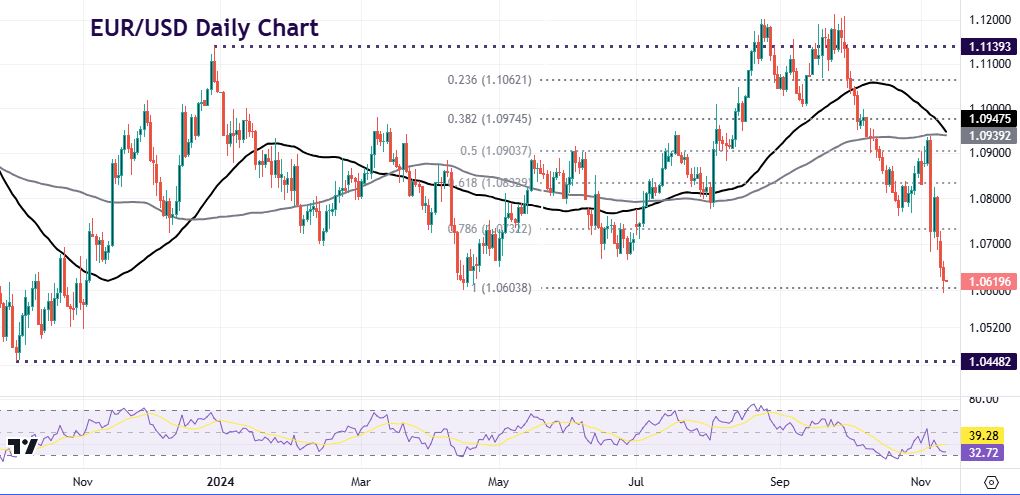Stocks log first drop since election day

* Wall Street indices dip with focus on Trump and economic data
* Dollar supported by rising Treasury yields, spurred by tariff expectations
* Gold extends to third session on advancing yields and USD
* Bitcoin briefly breaks above $90,000 amid meteoric 24-hour rally
FX: USD beat the first major top from late June at 106.08. Next up are the highs from April and May around 106.49/51. Bullish momentum is very strong at present as the Trump Trade and tariffs continues to be touted. The 10-year Treasury yield pushed higher, close to last Wednesday’s peak at 4.47%. News flow was relatively thin with eyes on today’s US CPI numbers.
EUR continues to get sold as rate differentials carry on getting wider. The ECB rate cut in December is getting a lot of attention. The chance of a jumbo-sized 50bps move is edging higher, with around 30bps currently priced in, so a 60% chance. Does President Lagarde really pull the trigger ahead of Trump 2.0?
GBP broke down aggressively, falling through the support zone at 1.2833/62. We said yesterday if we lose this, we could fall sharply to 1.2729 which is what happened. Wage growth printed slightly stronger than forecast but the jobless rate went up to 4.3% from 4.0%. The pound is now virtually flat on the year versus the dollar, having opened at 1.2729 at the start of 2024.
JPY tried to break higher above resistance and last week’s highs at 154.69/70. The US 10-year Treasury yield rose, helping the major and widening the rate differentials between Japan and the US.
AUD sunk close to the spike low on the US election at 0.6511. USD/CAD advanced above long-term resistance at 1.3946.
US Stocks closed in the red for the first time in a week. The S&P 500 settled 0.29% lower at 5,984. The tech-laden Nasdaq 100 lost 0.17% to finish at 21,071. The Dow finished down 0.86% at 43,911. Sectors closed largely negative with only Communications, Technology, and Consumer Staples in firmer territory, with Materials and Health lagging. The small-cap Russell 2000 sharply underperformed after doing surprisingly well recently, even though bond yields have been rising. They are normally tough for smaller companies, but the chance of tax cuts for businesses has been helping. Telsa dropped over 6% but this comes after adding more than $300 billion in market cap since the US election night.
Asian stocks: Futures are in the red. Asian stocks were mixed as they struggled to build on the Trump Trade and record US trade indices. The ASX 200 was subdued on mining weakness amid softening commodity prices. The Nikkei 225 pared its gains even on yen weakness. The Hang Seng notably underperformed on tech and auto worries on tariff worries. The Shanghai Composite was also under pressure on muted data.
Gold dropped to the next support level is at $2594. That is the next Fib level (38.2%) of the May to October move. Below here is the 50% mark at $2533 and the 100-day SMA at $2537. The strong dollar is proving a major headwind.
Day Ahead – US CPI
It’s the first big test of the post-election environment with key US inflation data released later today. The headline is forecast to rise 2.6% y/y, two-tenths higher than in September, with the monthly gauge steady at 0.2%. The core readings, which strip out volatile food and energy components, are expected at 3.3% y/y and 0.3% m/m which would be unchanged from the prior prints.
Recent core inflation gains have exceeded estimates. But despite possible concerns, Fed officials have cut rates. The evidence of above-trend growth and recent CPI upticks reduced the Fed’s inclination to front-load cuts. Sustaining recent momentum could force the Fed to retreat from its rate cut guidance offered in the September dot-plot. And soon, Fed officials must of course consider Trump’s fiscal policies.
Chart of the Day – EUR/USD sinks to support
The extensively followed two-year spread between EUR and USD rates is a big driver of the major. It is now at the widest it’s been since 2022. At that time, EUR/USD was trading near to parity, though surging energy prices were largely to blame. Now Trump’s upcoming tariffs and policies may rocket fuel the US economy, which has been growing near 3%. That is in sharp contrast to a eurozone engulfed by stagnation and the nearby Ukraine conflict.
Prices have dropped sharply since topping out just above 1.12 in September. The decline paused in late October easing oversold conditions but resumed aggressively last Wednesday. The mid-April bottom is at 1.0601. The next major low after this is from November 2023 at 1.0516 and the October trough at 1.0448.

The information has been prepared as of the date published and is subject to change thereafter. The information is provided for educational purposes only and doesn't take into account your personal objectives, financial circumstances, or needs. It does not constitute investment advice. We encourage you to seek independent advice if necessary. The information has not been prepared in accordance with legal requirements designed to promote the independence of investment research. No representation or warranty is given as to the accuracy or completeness of any information contained within. This material may contain historical or past performance figures and should not be relied on. Furthermore estimates, forward-looking statements, and forecasts cannot be guaranteed. The information on this site and the products and services offered are not intended for distribution to any person in any country or jurisdiction where such distribution or use would be contrary to local law or regulation.
